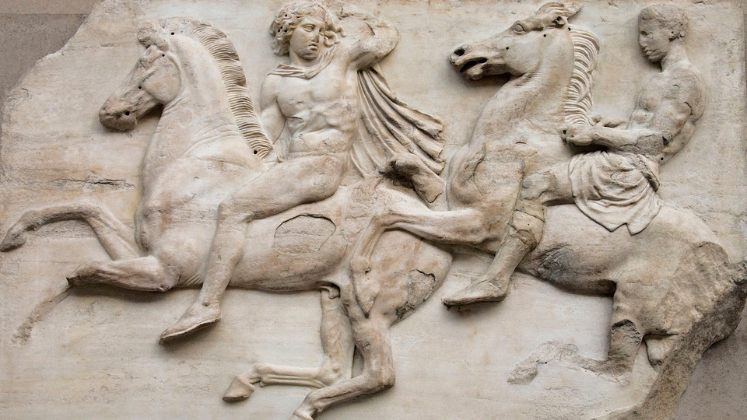During the French Revolution, a group of Carmelite nuns were executed by the guillotine, becoming memorialised as the Martyrs of Compiègne. Their story inspired works of art, operas, plays, and poetry — Jane Fitzpatrick looks at what we can learn from them.

A favourite among opera houses around the world, Francis Poulenc’s Dialogues des Carmélites has enthralled audiences from a variety of traditions and backgrounds for nearly seventy years. So, what is it about these Catholic nuns of the French Revolution that continues to captivate and haunt us after so many years?
The History
Francis Poulenc’s opera portrays an actual event that took place during France’s notorious Reign of Terror in the late 1700s. The nation faced significant social and political upheaval that led to the infiltration of religious institutions and the condemnation of those still abiding by tradition to death. A group of Carmelite nuns in Compiegne experienced this terror themselves when they were taken to trial for refusing secular lives. They were beheaded, as many were, but their story was not forgotten.
German author Gertrud von le Fort found records of the nuns’ deaths and published a short book in 1931 that retold their heroism with the addition of her own leading character, Blanche de la Force. Blanche’s story then became a longer work entitled Dialogues des Carmélites written by Georges Bernanos, a French author and a soldier during the first World War. French composer Francis Poulenc, inspired by Bernanos’s contribution, added his own work to the lineage by creating both the libretto and the musical score for an opera by the same name.
The Story
Blanche de la Force is the young, skittish daughter of the Marquis de la Force. Looking to escape the fears of her everyday life yet hoping for her own heroic journey, Blanche decides to join the Carmelites of Compiegne, a Catholic order of nuns who shun themselves away from society for a life of devout and undisturbed prayer.
Blanche’s father becomes a victim of the rising Revolution in France, and the same danger threatens the Carmelites, despite their distance from society. Blanche flees the convent in order to escape death, but she willingly joins her sisters at the scaffold in the final scene, having found her courage and faith.
Sounds and shadows of a guillotine have left many audiences haunted and in awe of such a display of bravery.
Traditional and Modern
Francis Poulenc’s Dialogues des Carmélites has seen many stages across the world, from the Teatro alla Scala in Milan to the Metropolitan Opera in New York City. Because of the story’s historical context combined with the plainness of the Catholic Carmelite lifestyle, productions of the work have often revelled in traditional simplicity, from costumes, to sets, and props. While operas like La Traviatta have found new inspiration in more modern settings and attire, the Carmelites remain fixed in their time and space. Or do they?
Glyndebourne offered a new production of Dialogues des Carmélites this year by Australian director Barrie Kosky that featured modern riot helmets as well as denim, hoodies, and jeggings in the casts’ attire.
However, it isn’t just the modern twist in clothing that keeps Poulenc’s work relevant.
The beauty of the arts in a social perspective is that they continuously offer new ideas in an ever-changing world. The challenges that the Carmelites of the French Revolution faced are not all that distant from us in the modern world, and there are still so many lessons embodied in their religious sacrifice that many of us can learn.
The Lessons We Are Still Learning
The Carmelites of Poulenc’s tragedy represent the martyrs and honoured saints of Catholic tradition, but their heroism extends far beyond the Christian community.
Women have long embodied both purity and impurity simultaneously throughout religious history and across traditions. They have been expected to dress and act modestly, but their bodily functions may cause or create uncleanliness and sin. This trapping dichotomy extends to what is considered the secular and social spheres, as women’s clothing and behaviour continue to be scrutinised at various levels.
Despite having separated themselves to create the most devout existence centred around prayer and purity, the Carmelites were marked as symbols of ancient evils in a modernising society. More recently, we have seen the social condemnation of women in France who wish to devoutly abide by the teachings of Islam through their clothing. Those resisting bans on religious adornments are resisting the same kind of secular prohibition of religious behaviours and expressions that the Carmelites faced centuries ago.
No matter the time or place, the story of French nuns who died for their faith long ago continues to find a home in hearts that ache with the same pains. Women see themselves in the strength of Poulenc’s singing heroes, and their loved ones mourn for those who have fallen victim to traditional, political, and social pressures in their many forms.
Although the guillotine is a threat of the past, persecution and sacrifice remain all too familiar. That is why the Carmelites still haunt us and why they still inspire us to keep standing tall, no matter our faiths nor our backgrounds.




